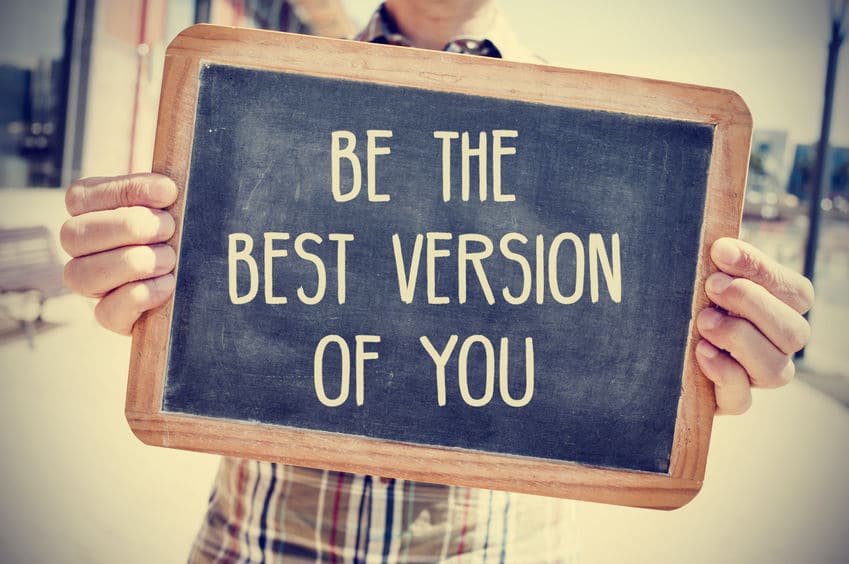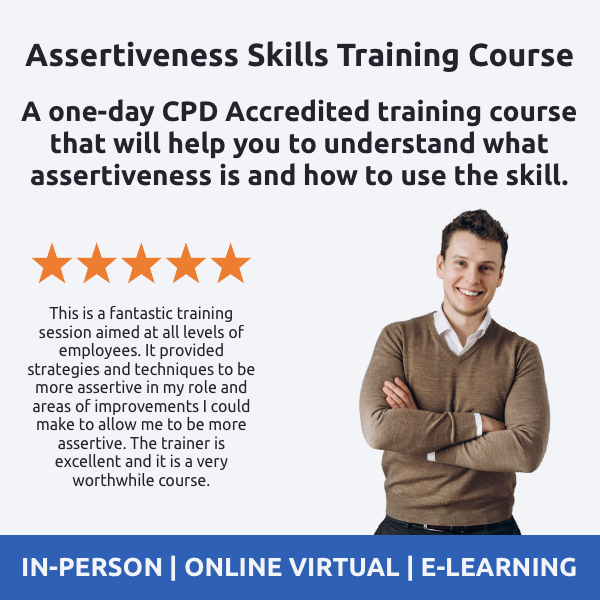Developing Assertiveness
You can learn more about the content of this post in our Assertiveness Skills Training Course.
It is common for Assertiveness to be defined as a skill; something you develop with time and practice. To a certain extent, this is true and to be encouraged:
You can learn about or otherwise copy the behaviours that ‘assertive people’ demonstrate:
- You can go into detail about the subtle adoption and adaptation strategies associated with assertive body language; direct eye contact, open gesturing, upright posture (and power-posing that has become so popular of late) and so on.
- You can explore the tonality of somebody who sounds assertive; calm, even-toned, appropriate emphasis placed on keywords and a lowered pitch to finish a statement to lend it ‘weight’ and a sense of gravitas for instance.
- And, you can listen for language patterns that demonstrate assertiveness too; ‘I statements’ that serve to empower the individual such as I want…, I feel…, I think…, empathetic phrases and ‘super questions’ that cut through ambiguity in communication such as, “I can appreciate your frustration, which part of the product are you struggling with exactly?” and using people’s names when inviting a response or when making a request, are some helpful word-based ideas.
On this premise, ‘behaving assertively’ most often seems to be the goal of developing assertiveness.
The Truth About Assertiveness
Whether you are defending yourself from being taken advantage of, offering your opinion in a meeting, asking to join a project team for career enhancement or simply saying no to a request for help, behaving in an assertive fashion is the evidence of assertiveness and your relative success in each case, the measure of assertiveness.
But, the truth about assertiveness is not in the goal or the evidence or even in the measure of success. Assertiveness is fundamentally an internal matter.
As such, the truth about assertiveness lies in the thoughts and feelings you and I have about ourselves, about others and about the world at large. This means building assertive skills through practice (again, to be encouraged) can either be helped or hampered by what’s going on in our heads and in our bodies. It is useful therefore to consider what it is that we think about ourselves, others etc and to become more highly alert to how one’s body reacts to situations where behaving assertively feels challenging.
When we work on our internal narratives and our internal state it has a direct effect on our behaviour.
Internal Narratives
For example, when I carry an internal narrative that says, ‘I could never stand on stage and run a town hall meeting’ we tend to unconsciously believe the narrative. As far as we are concerned, it is a true statement, rather than just a reactive thought that we have most likely built over several repetitions through similar kinds of situations we faced in the past. (The trick is to recognise that the thought seems to have served a useful purpose in the past (because I am here to tell the tale – the strategy followed must have been right, as I’m still intact) and that that only makes it useful then and not necessarily now.)
In this case, the internal message or belief, “I could never…” most likely turn into the behaviour ‘I don’t do it. It may also be supported by other less conscious thoughts such as, “people will judge me”, “I’m not good enough”, “if I put myself forward, I risk being made into a fool”.
When we give some careful consideration to our internal narratives (imagining challenge scenarios or remembering difficult ones is a good idea here – note: major trauma for example should be managed with the help of appropriately trained professionals) we can become more aware of what we think and feel in these kinds of situations. The idea is not to push away or ignore these existing thoughts and feelings but rather to engage with them more closely to explore their significance and current relevance. When we start to see thoughts and feelings as simply reminders of the past, not determiners of the future we can begin to change the narrative.
At first, it may be useful to simply change the language associated with the thought and ‘soften it up’ a little. “I could never…,” or “I’m not good enough” could become, “I could develop what I need to do this in the future”. Supportive thoughts might include, “many people like me have faced this and many have succeeded, I can be that person”, “people will judge me no matter what I do and that’s just normal and not my concern”, “I can cope with feeling foolish better than regretting limiting myself and my future career”. You can choose to think whatever you want – you just have to do it consciously and repetitively for it to affect the existing patterns of thought that you chose to think in the past, even if you weren’t aware of it.
Internal State
It may be reasonable to state that our feelings are our thoughts reflected in the body. It is certainly safe to say that thoughts and feelings are intimately linked and can feed each other – positively or negatively, depending on the direction the initial process takes.
So, adapting your internal narratives will certainly affect your feelings. Even if this is difficult to clearly quantify, it should form part of your plan to build assertiveness.
Another useful tool that can have a significant impact on managing your internal state is anchoring.
I’ve found anchoring useful at work in preparing for interviews and presentations where I was able to bring an immediate calm and sense of confidence to my internal state, just as the interview or presentation began. I also found it useful as a coping strategy when my prematurely born son needed several life-saving surgeries and 6 months in hospital before we brought him home and through which my wife and I were continually challenged to remain calm, focussed and patient. More than any other time in my life I had to call upon assertiveness to deal with clinicians and surgeons in a world where I had very limited knowledge, no credibility and no experience. I can testify for my part that my state of mind and my feelings were both my greatest strength and my biggest potential weakness. Thankfully I most often chose the former rather than succumb to the latter.
Anchoring
Anchoring involves using memory or imagination to generate intense positive, calm, confident, clear, focussed, pleasant (or whatever other useful feelings you want to have) states in the body by engaging in those memories or imagined scenarios where this happened or happens as a natural bi-product.
I usually recall a swimming gala from my school days that I remember distinctly. I was stood on the starting blocks preparing to listen for the starters instructions and, instead of the usual thought ‘if I do what I know I’m capable of I should be able to get a podium finish’ a different thought was in my head. ‘I’m going to win this!’
This thought stemmed from the fact that Chris Bird (who swam like a fish) was absent that day. My state of mind was transformed from one of slight frustration that, as one of the best swimmers in the whole school, I was still streaks behind the best and would invariably be fighting over second place to; I’m going to win! I could feel a rush of energy surge through my body; it was like a mixture of goosepimples and pins and needles that seemed to make me feel lighter and more grounded all at the same time. My mind was clear as I focussed on the crackling positive energy that filled my body and even seemed to surround me in a sort of powerful aura. As I threw myself into the water upon hearing the starting pistol, I felt extraordinary: ordinary but with something extra – a sense of energised relaxation which allowed me to perform almost effortlessly.
As I close my eyes now and vividly remember this brief victorious episode from my childhood, it doesn’t take long for my body to begin to crackle a little, for me to get a slight shiver up my spine and, if I focus intensely on those fleeting feelings, to be able to generate an intensely pleasant buzz that I then ‘anchor’ by squeezing together my right thumb and middle finger for just a few seconds just as the feelings are at their most intense.
I repeat this process over and over; go into the memory, generate the feelings, enhance and intensify the feelings by focussing directly upon them and imagining them running round my whole body, and then ‘capturing’ the moment in the squeezing of my fingers.
Hacking Your Own System
The idea is to create a strong association between the internal state (whatever you want that to be) and the action of the squeeze. After many repetitions (I’d go along with the 21 repetitions notion of habit forming/breaking) you may find it possible to simply squeeze and observe the feelings come rushing back. This then gives you a ‘trigger’ that you can pull in those moments when you want to assert yourself. What better way to support good practice in assertive behaviour than to flood your body with positive sensations right in the moment when it is most useful. Like most associations and memories, the bonds can weaken over time or be changed by other factors so, consider it more like a skill – if you don’t use it, you lose it. Just keeping it topped up is a positive experience, and therefore, like skills practice, to be encouraged.
When one combines learning and applying the behaviours of assertiveness with addressing internal narratives and generating internal states, it improves the quality and depth of your development.
The aim then is to move to a place where assertiveness becomes an easy and natural choice in a wider range of situations by bringing these ideas to the fore in each new challenging situation as it arises.
Assertiveness Skills Training Course
You can learn more about all of the points in thus post, including how to be more assertive by attending our Assertiveness Skills Training Course. We deliver our assertiveness course as an online virtual training course or an in-person training course.












